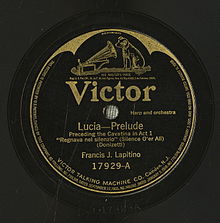Talk:Lucia di Lammermoor
| This article is rated Start-class on Wikipedia's content assessment scale. It is of interest to the following WikiProjects: | ||||||||
| ||||||||
 | The content of this article has been derived in whole or part from http://www.operajaponica.org/. Permission has been received from the copyright holder to release this material Under the GNU Free Documentation License. Because this permission was received prior to 1 November 2008, you may use the material under either that license or the Creative Commons Attribution-ShareAlike 3.0 Unported license. Evidence of this has been confirmed and stored by VRT volunteers, under ticket number 2005110510001389. This template is used by approved volunteers dealing with the Wikimedia volunteer response team system (VRTS) after receipt of a clear statement of permission at permissions-en |
Untitled
[edit]I have added a synopsis. Kleinzach 00:53, 3 November 2005 (UTC)
I added some notes on the French version of Lucia.
I'm unsure of the reason stylistic interpretations are placed under performance history. Any ideas on where to put them? Under the music section (which doesn't exist yet), categorized under style (which, also, doesn't exist yet)? Sutherland4l (talk) 02:49, 14 April 2009 (UTC)
Is the media generated from midi? It sounds rather unauthentic... Maycontainpeanuts 04:02, 26 September 2007 (UTC)
- Yes, it appears to be, and it's dreadful frankly. Does nothing to enhance the reader's understanding or appreciation of the score and in in fact gives no idea of what the composer intended it to sound like. Unless there are any objections, I'm going to remove it and simply add a link to the Commons at the end of the article. Voceditenore (talk) 08:49, 8 June 2010 (UTC)
Arias, Duets and Ensembles
[edit]The phrase "arias, duets and ensembles" is used to encompass all the vocal works of an opera, including vocal trios, quartets, quitets and sextets. Are there any I've missed? Oconnell usa (talk) 05:10, 6 February 2009 (UTC)
Specific Artists
[edit]I'd like to suggest that references to specific artists be deleted from this article. Otherwise, it may become a "battle of fan clubs." I prefer Lily Pons's performance of Lucia to those of the other listed artists, but rather than list her, I'd rather see the other references deleted. Any dissents? If there are no dissents, I'll do so in a month or so. 19 April 2009. —Preceding unsigned comment added by 70.59.27.111 (talk) 00:29, 20 April 2009 (UTC)
- I agree. The list is potentially endless, attracts drive-by additions, is inherently non-neutral, and does not illuminate the article at all. See also this discussion at [[WP:WPO|WikiProject Opera]. I've removed them. Voceditenore (talk) 08:49, 8 June 2010 (UTC)
Glass harmonica
[edit]Why is there no reference to the original version of the mad scene being written for glass harmonica? —Preceding unsigned comment added by 79.92.10.17 (talk) 19:08, 14 May 2011 (UTC)
The comment on Scottish stereotypes in the 1830s is a bit loose. (Scott's novel "The Bride of Lammermoor" was actually published in 1819 originally. When was the first Italian translation?) We are informed by another incarnation of Wikipedia that as far as Scott was concerned it had its roots in actuality, both in his own family history and his personal experience. He wasn't "making use of stereotypes". Perhaps Cammarano might have been.Delahays (talk) 16:54, 19 October 2014 (UTC)
More music
[edit]
I suggest to include the music and image at right.Anythingyouwant (talk) 02:25, 24 October 2015 (UTC)
Question about the scoring
[edit]At the moment, the article says that the scoring includes two trumpets, in B-flat, A, D & E. That would seem to need four instruments, unless it means that their part is written in A, D and E, with the trumpets themselves being pitched in B-flat, which is normal. If anybody knows just what's meant, it should be clarified so that those of us who aren't musicologists can understand it. JDZeff (talk) 23:44, 10 November 2017 (UTC)
- Page 1 of the score lists 2 horns (E-flat, B-flat), and 1 trumpet (B-flat). Someone needs to wade through the whole score to confirm or reject the others, or find a reputable source that lists the instrumentation. In the meantime, those claims, marked as unverified, ought to be removed. -- Michael Bednarek (talk) 04:32, 11 November 2017 (UTC)
Sextet
[edit]I'm surprised that so little is said about this number, by far the best known in the Opera.
A Commons file used on this page has been nominated for deletion
[edit]The following Wikimedia Commons file used on this page has been nominated for deletion:
Participate in the deletion discussion at the nomination page. —Community Tech bot (talk) 19:21, 11 October 2018 (UTC)
The 17th Century?
[edit]Scott's novel is set in the early 18th century, around 1707, the era of The Act of Union. Did Donizetti change the dates? — Preceding unsigned comment added by 2001:8003:3010:700:E444:F7E0:ABCF:730A (talk) 20:43, 13 June 2022 (UTC)

